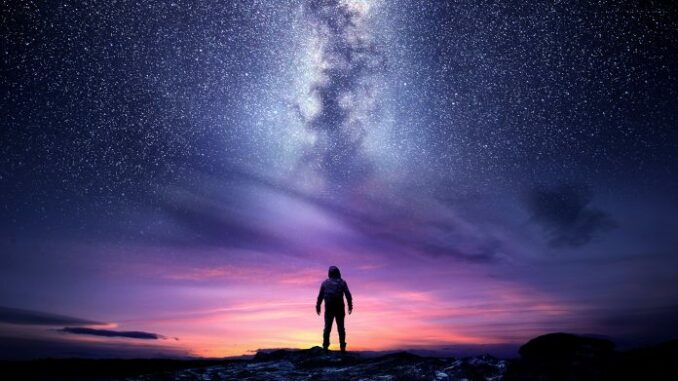

Humans have been staring up into space for thousands of generations to have a rational and coherent description of the Creation and evolution of the universe. Guru Nanak, the first Sikh Guru, in his hymns of Jap (u), Aasa di Var, Sidh Gosht, Thitee and Maru Sohilé, has enunciated an excellent understanding of the mystery of Creation.
Before Creation
In Guru Nanak’s hymns, many interesting facts about the state before the start of Creation are described. In his hymns of ‘Maru Sohilee,’ he articulates: “For endless eons, there was only utter darkness. There was no earth or sky; there was only the infinite Command of the Creator. There was no day or night, no moon or sun; The Creator sat in primal, profound Samaadhi. ………There were no sources of Creation or powers of speech, no air or water. There was no creation or destruction, no birth or death. There were no continents, no nether regions, no seven seas, no rivers or flowing water. (SGGS, p. 1035)……. “The dazzling light glitters, although neither the moon nor the stars are shining; neither the sun’s rays nor the lightning flashes across the sky. I describe the indescribable state, which has no sign, where the all-pervading Lord is still pleasing to the mind. (SGGS, p. 1033).”
Interestingly, Guru Nanak’s above views have been endorsed by the prevalent scientific ideas about the state before the start of Creation. By analyzing the light emanating from distant galaxies, nebulae, and pulsars, scientists have calculated that our universe was born about 13.8 billion years ago. Many theories are in vogue about its origination. However, none can describe the state before the Creation of the universe. Nevertheless, scientists agree that there was nothing like the moon, the sun, the earth, the galaxies and the day or night before the Creation of the universe.
Origination – The Primal Cause
Reporting on the origination of the Creation, Guru Nanak proclaimed that it is impossible to know precisely when the Creation began. He said, “When the Lord (Creator) so willed, the world was created. Without any visible support, he sustained the universe. (SGGS, p. 1036).”…… “Only the Creator knows when and how the universe was created. (SGGS, p. 4).”
On the scientific front, in 1930, astronomer Georges Lemaitre suggested that about 13.8 billion years ago, all the matter of the universe was contained in a primal atom called a ‘cosmic egg.’ It exploded, and its many fragments gave birth to planets, stars, galaxies, etc. This theory is popularly known as the Big Bang theory. In 1948, cosmologists Harmann Bondi, Thomas Gold and Fred Hoyle proposed the Steady State Theory, suggesting that the universe was eternal and has always existed. In 1965, another astronomer, Allan Sandage, developed the ‘Pulsating Universe Theory.’ He indicated that the universe is created, destroyed and then re-created in 86 billion–year cycles. A universe is, in other words, not without end but with an infinite number of endings … and beginnings. Thus, scientists have diverse views about the universe’s birth and its ultimate fate. Unfortunately, they cannot say something definite about it with strict certainty.
Process of Creation
Guru Nanak, in his ‘T’hitee’ composition, points out the process of Creation of the universe as: “The Creator created the universe, joining the elements together. Then, breaking the cosmic egg, he created the forces of attraction (union) and repulsion (separation). Next, IT made the earth and the sky the places to live. Finally, he created day and night, fear and love. The One, who created the Creation, also watches over it. (SGGS, p 839).” In ‘Jap(u)’ bani, Guru Nanak describes the process of Creation of the universe as; “You created the vast expanse of the Universe with One Word! After that, hundreds of thousands of rivers (the process of generation) began to flow (emerged). (SGGS, p 3).” Guru Nanak’s description of the beginning process of Creation is surprisingly similar to the descriptions provided by the “Big Bang” and “Pulsating Universe” theories, as explained above. It is pertinent to add that Guru Nanak expressed these views about 425 years before the discovery of the Big Bang Theory.
Time of Creation
Guru Nanak, in his composition ‘Jap(u),’ has raised an apposite question concerning the time of Creation. It asks, “What was the time, and what was the moment? What was the day, and what was the date? What was the season, and what was the month when the universe took its shape? Had Pandits (Hindu scholars) known the time, it would have been written in Puraanas. Had Qazis known the time, it would have been written in Quran. No Yogi knows the time, the weekday, the month or the season of the Creation. The Creator who created this Creation only IT knows about it. (SGGS, p. 4).” Herein, Guru Nanak has clearly pointed out that it is impossible to know the exact time or day of the origination of Creation by any means.
Learning about the time of Creation using science, we come to know that there have been several different ideas in vogue about the time of Creation among people. Until the 18th century, scientists were convinced that our earth was only a few thousand years old. Using geological data and analyzing the fossils, Kelvin, a famous scientist, suggested by the second half of the 19th century that the earth is about 20 million years old. During the 20th century, using the ‘Radioactive Dating Technique,’ it became known that our planet was created about a few billion years ago. Astronomer Georges Lemaitre has reported that the universe’s origination occurred about 13.8 billion years ago. The Steady State Theory suggests that the universe is eternal and has always existed. The Pulsating Universe Theory reports that the universe’s birth happened about 13.8 billion years ago. But none of the theories say any precise date of Creation. Even with the help of currently available very advanced scientific techniques, scientists still need to pinpoint the exact time or date of the universe’s origination. It conforms to Guru Nanak’s assertion.
Vastness
Elaborating on the vastness of Creation, Guru Nanak, in his ‘Jap(u)’ composition, proclaims that Creation is limitless. He declares: “The limits of the Creation cannot be perceived. The limits of its near (micro) and far (macro) extremes cannot be discerned. Many struggles to know these limits, but these cannot be determined. None is able to know these limits. The more you say about these, the more there remains to be said. (SGGS, p. 5).” Modern scientific research proclaims that our universe, with over 200 billion galaxies, each containing approximately 100 billion stars, is quite extensive. The observable universe is a few tens of billions of light years across. A light year is the distance travelled by light in one year at the speed of 0.3 million km/s. It is equal to 9460 billion kilometers. Astronomers have pointed to the existence of heavenly bodies as far as 30 billion light years from the earth. Despite the latest space technology, scientists have yet to find the edge of the universe to date. This fact is in accordance with Guru Nanak’s claim about Creation’s immensity.
Furthermore, Guru Nanak articulates the existence of countless universes as; “There are planets, solar systems and universes. If one has to describe these, then one can only say that these are unlimited. Therefore, there are countless worlds in the Creation. As is ordained, so these exist. (SGGS, p. 8).” Contemporary science has also pointed out the possibility of the existence of multi-universes. Guru Nanak’s these ideas, propounded about 550 years ago, appear to be the precursor of modern science.
Origin of Life
Guru Nanak, in his hymn of ‘Siri Raag, ‘ describes the origin of life. He proclaimed, “From the True Lord (ultimate reality) came the air, and water came from the air. The three worlds (living beings in air, water and space) were created from water. In every heart, his essence is infused. (SGGS, p. 19).” These ideas of Guru Nanak have been affirmed by prevalent scientific views about the origin of life, as explained hereunder.
Until the middle of the nineteenth century, life was generally thought to be created by some supernatural power, the Creator or God, out of nothing. According to modern science, about 13.8 billion years ago, the ‘Big Bang’ occurred. About 5 billion years ago, swirling clouds of cosmic dust began to condense to form our solar system. Our earth was scorching when it came into existence. There was great volcanic activity on land. The release of gases from the earth’s womb led to the formation of the gaseous envelope (containing water vapors) around it. With time clouds took their shape. Then it rained on the earth for several hundred years. The rainwater flooded the earth and cooled it. In the shallower parts of the earth, the water took the form of seas. Life, in the form of unicellular animals (e.g. Amoeba & Protozoa), is thought to have originated in seawater. From seawater, many organisms later invaded fresh waters and land. The present complex animals and plants have been produced by gradual change in the earlier simpler life forms. Darwin’s theory of natural selection is today recognized as the main factor in the evolution of animal and plant life.
Diversity of Life
Biodiversity refers to genetic variation, species variation, or ecosystem variation within the natural world. As an illustrative measure, Guru Nanak describes the abundance and diversity of the natural world in his hymns. He reports: “8.4 million species of beings were created. (SGGS, p. 1190).” Scientists, too, say that there exist a wide variety of creatures/forms, numerous varieties of colors and species on our earth. Based on rigorous data, a recent estimate is that about 8.7± 1.3 million types of vegetation and animals are present on our planet.
Ultimate Fate of the Universe
Elaborating on the ultimate of the universe, Guru Nanak proclaims that the end of the universe would lead to the pre-creation stage. He declared, “From this Primal Void came the four sources of Creation and the power of speech. They were created from the Void and will merge into the Void. (SGGS, p. 1037).”
Cosmologists have reported three different outcomes on the end of the universe based on its critical density. If the critical density of the universe were high, then there would be enough gravitation force to slow and eventually halt its expansion. Then, after billions of years, it would collapse again, resulting in Big Crunch. It could create another Big Bang, leading to the rebirth of the universe. If the critical density of the universe were low, then there wouldn’t be enough gravity to hold things together. The expansion would continue forever and ever. Galaxies would spread apart; Stars would die. Eventually, everything would cool down to the background temperature of the universe, leading to a Big Freeze. The third scenario suggests that if the critical density of the universe were just right, it would lead to its forever expansion and continuous slowing down. Such a Universe will reach a dead stop in an infinite amount of time. Recent research favors such a scenario. But, the observations are inconclusive, and alternative models are still possible.
As is apparent, Guru Nanak has enunciated an excellent understanding of the mystery of Creation. It is pertinent to add that he composed his hymns in the late fifteenth and early sixteenth centuries. In contrast, the above scientific ideas became prevalent in the second half of the eighteenth century. Thereby it is evident that Guru Nanak’s ideas were the precursor of the modern scientific outlook.
(Author thankfully acknowledges the inspiration and feedback provided by Dr. Bhai Harbans Lal, Dallas, Texas, USA)
(Dr. Devinder Pal Singh is the honorary Director of the Center for Understanding Sikhism, Mississauga, Ontario, Canada. He is the author of a scientific treatise based on Gurbani, titled: “Science and Sikhism- Conflict or Coherence.” Web: c4usikhism.com)





Be the first to comment